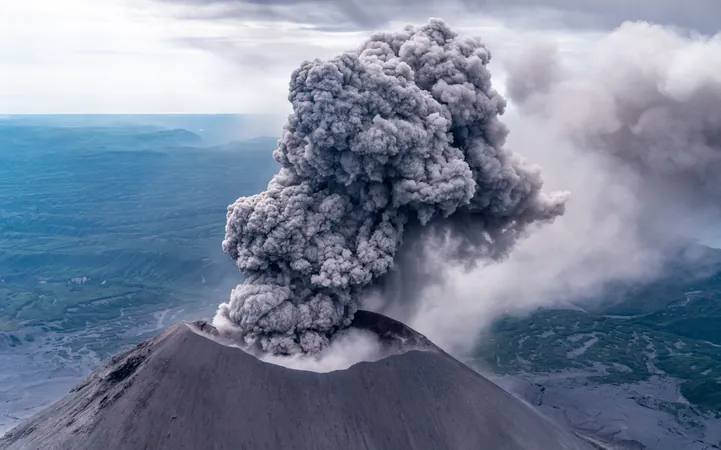
Volcanic Ash: The Surprising Architect of Cloud Formation
2025-05-27
Author: Siti
Volcanic eruptions are famous for their dramatic impacts, from grounding flights to fertilizing vast oceans. However, a lesser-known but equally significant effect is how volcanic ash affects the formation of high-altitude ice clouds. New research from the Lawrence Livermore National Laboratory (LLNL) sheds light on this intriguing phenomenon.
How Volcanic Ash Shapes Clouds
Researchers have tapped into a decade’s worth of data collected by NASA’s CloudSat and CALIPSO satellites. These advanced tools measure the size and quantity of ice crystals and monitor ash plumes within clouds. The team focused on three major eruptions: Kasatochi in Alaska (2008), Sarychev in Russia (2009), and Calbuco in Chile (2015), providing insight into how volcanic particles affect cirrus cloud formation.
Lead scientist Lin Lin noted, "Our research bridges a significant gap in understanding how volcanic eruptions influence cloud dynamics." Unlike other aerosols like dust and pollution, which rise slowly and are more difficult to analyze, volcanic ash presents a unique opportunity for study.
Expectations vs. Reality
Initially, the research team anticipated a visual landscape of dense clouds loaded with small ice particles. However, the data revealed a starkly different picture: clouds affected by ash contained fewer but larger ice crystals. Moreover, these clouds appeared more frequently at higher altitudes where ash circulated.
The Mystery of Ice Nucleation
You might wonder: how does the introduction of more particles lead to fewer ice crystals? The answer lies in the process of ice formation. In pristine air, ice can form spontaneously at extremely low temperatures. However, volcanic ash provides rough mineral surfaces that allow water molecules to freeze at warmer temperatures, a process known as heterogeneous nucleation. This leads to only a few ash grains capturing vast amounts of water vapor, resulting in oversized ice crystals.
Impact on Earth’s Climate
Cirrus clouds play a pivotal role in our planet’s energy balance. They allow sunlight to enter but also trap heat escaping into space. Interestingly, clouds with fewer, larger ice crystals might be more transparent to infrared radiation, potentially cooling the planet. Volcanic ash can thin these clouds, which may offset some short-term warming effects from other volcanic aerosols.
Broader Implications
The findings go beyond volcanic eruptions; ash particles have similarities to desert dust, prevalent in the upper atmosphere. This suggests that dust could also influence cloud formation and the greenhouse effect, particularly in areas like the Sahara.
Enhancing Flight Safety and Climate Models
Understanding how volcanic ash alters cirrus clouds has practical applications for aviation safety. Traditional maps focus on ash density, but insights into cloud changes can affect satellite monitoring and plume tracking. Additionally, the research provides crucial satellite-verified data to improve climate models and their handling of ice nucleation in ash-laden conditions.
Looking Toward the Future
While major eruptions are rare, they serve as essential real-world laboratories for scientists studying the ash-cloud connection. Future eruptions combined with advanced sensors will allow researchers to explore whether the patterns observed hold true across different atmospheric conditions.
This extensive study underscores the role of volcanic ash as a significant player in cloud physics and climate dynamics, demonstrating how geologic events can interconnect with weather patterns in surprising ways. Lin reinforces this idea, stating that "unexpected discoveries often challenge our original assumptions, driving scientific progress."
The complete findings are detailed in the journal "Science Advances."


 Brasil (PT)
Brasil (PT)
 Canada (EN)
Canada (EN)
 Chile (ES)
Chile (ES)
 Česko (CS)
Česko (CS)
 대한민국 (KO)
대한민국 (KO)
 España (ES)
España (ES)
 France (FR)
France (FR)
 Hong Kong (EN)
Hong Kong (EN)
 Italia (IT)
Italia (IT)
 日本 (JA)
日本 (JA)
 Magyarország (HU)
Magyarország (HU)
 Norge (NO)
Norge (NO)
 Polska (PL)
Polska (PL)
 Schweiz (DE)
Schweiz (DE)
 Singapore (EN)
Singapore (EN)
 Sverige (SV)
Sverige (SV)
 Suomi (FI)
Suomi (FI)
 Türkiye (TR)
Türkiye (TR)
 الإمارات العربية المتحدة (AR)
الإمارات العربية المتحدة (AR)